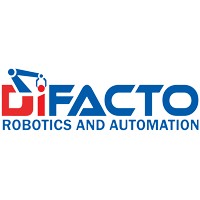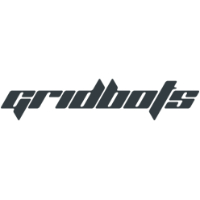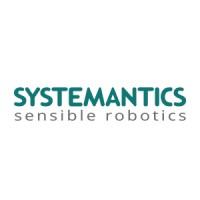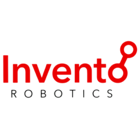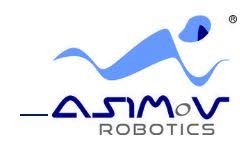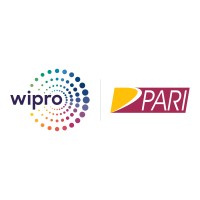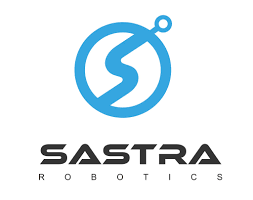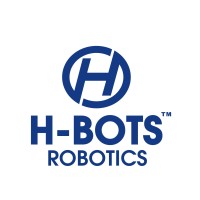Microelectronics world news
Top 10 Robotics Companies in India
A robot is a programmable machine capable of carrying out tasks autonomously or semi-autonomously. They are a combination of sensors, actuators, controllers, and mechanical structures that enable them to interact with their environment. Robotics is a multidisciplinary field that involves the designing, development, operation, and use of robots.
Top 10 Robotics Companies in IndiaWe have curated a list of top companies working in the robotics and automation sector in India.
DiFACTO RoboticsDifacto Robotics and Automation is among the leading robot solution providers in the manufacturing sector. Headquartered in Bengaluru, they serve diverse fields with their competitive automation services. Their products and services serve the following fields- automotive, metal forming, transportation, energy, electronics, white goods, yellow goods, and consumer goods.
DiFacto provides customized robotics solutions per customers’ requirements. Their product portfolio includes the following –
- Smart Loader
- Smart Robo Loader – DUO
- Servo Track
- Smart Conveyors
- Linear Gantry
- Mobile Machine Tender
Novus Hi-Tech is a well-known company providing advanced automation solutions for varied industries like – automotive, paints and chemical, construction and farm equipment, solar, food and beverage, consumer electronics, cell and battery, e-commerce, 3PL, retail, express delivery, construction and mining, and oil and gas. Novus’ product catalogue includes-
- Autonomous Mobile Robots
- Autonomous Battery Operated Pallet Truck
- Video Telematics for Fleet operations
- ADAS for OEMs
Working aggressively in Robotics – AI and machine vision, Gridbots is a major player in developing ultra-high performance systems that are effectively utilized in industries for dimension measurement, sorting applications, grading applications, etc. Their product catalogue segment is as follows-
- Automation – Self-driving Robots, Robotic Manipulators, Fully Integrated Robotic Systems
- Defence – Minehawks, Zeus, Humming Bird, Humming Bird Climber, Brute, Hawk, Katana, Sentinel, Bat
- Robotics Services – Stinger Pipeline Robot, Magnetic crawlers, Inspection Robot, Boiler Tubes Inspection Robot, Pipe Climber robot, Fir Fighter Robot
- Machine Vision – Glass Inspection Systems, Vision-based measurement, Fully Integrated Vision System
Systemantics have developed ASYSTR Collaborative Robots for automation that are flexible, affordable, and safe for business demands. They are among the first Cobots to be indigenously designed and manufactured in India. The 6-axis robotics arm- Cobots family comes in three payload options – ASYSTR 10C (Payload – 10kg), ASYSTR 3C (Payload – 3 kg), and ASYSTR 5C (Payload – 5 kg). Systemantics enables services in automation in sectors like- automotive, industrial, e-commerce & retail, academic & research, pharmaceutical, electronics, and food and beverage.
Invento RoboticsInvento has developed a Robotic avatar- MITRA for senior living facilities, with purposeful AI-powered conversations (video calls, news, jokes, cognitive games, etc.).
MITRA’s features include fall prevention and detection, monitoring and alerts, curated videos, health and wellness, conversations, exercise tracking, cognitive games, and family connections. Invento works with cutting-edge technologies like AI computer vision, deep learning models, speech synthesis, laser-guided navigation, etc. Accenture and Wipro are among its key partners.
ASIMOV RoboticsASIMOV is among the best in providing engineering solutions in robotic simulation and control, machine vision, virtual reality, and autonomous navigation. The primary areas it caters to are- medical, space, defence, sports, hospitality, space, banking, and retail, with a special focus on medical and healthcare.
The Product catalogue includes –
- Karmi Bot
- Sevabot
- Chhaya
- Sayabot
Innovation leader in automation and robotics technology, Wipro PARI designs state-of-the-art equipment. PARI works on competitive technologies including- Precision handling position, assembly and joining, measurement and testing, machine vision and sensors, flexible manufacturing, large interlinked system software, etc. Their turnkey solutions include- automated welding, machining, and assembly, automated warehouses and In-plant logistics, and automated car parking systems with over 2000+ installations.
Sastra RoboticsSastra makes rigorous testing that is beyond human capabilities possible. They develop robotic solutions for human-like automated functional testing of physical devices. Sastra caters to industries like – automotive, banking and fintech, mobile, aviation, and medical.
The product portfolio includes –
- Quaco Pro – complete test systems
- Tacbot – portable test system
- Dimenzio Mini – Environment chamber testing
- Quaco Standard – standard speed testing
- Tafin – gyro sensor testing
- Dimenzio MG – table-top high-speed testing
- Quaco Pro S
- Dimenzio BG
- Dimenzio Helium
H-Bots specializes in developing world-class robotics solutions for industries like manufacturing, healthcare, logistics, etc. They are known for developing affordable state-of-the-art robotics solutions. Their Health Robot works miracles in serving the healthcare industry with its advanced functionalities. It helps doctors in their clinical workflow and improves patient experience. Their Warwick Robot is specially designed for research and development purposes with advanced cyber-security and real-time information features.
Unbox RoboticsUnbox Robotics is a major supply chain robotics technology company working in robotics-based distribution technology. It caters to small to large e-commerce, retail, and logistics companies. Its UnboxSort bot serves multiple purposes including Parcel sortation and order consolidation. The bot specializes in scanning, sorting, and dispatching packages through a compact vertical sorting robotic solution.
The post Top 10 Robotics Companies in India appeared first on ELE Times.
EPC launches laser driver boards showcasing AEC-Q101-qualified GaN FETs’ rapid transition for superior LiDAR system performance
Top 10 Data Analytics Companies in India – ELE Times
Data analytics certainly has been the game-changer in the field of corporate planning. Optimizing enterprise performance is dependent upon the science of deriving insights from data for decision-making. It’s more important than ever to find economical and effective ways to handle, use, and convert the massive volumes of data that businesses are gathering into insights that can be used.
This article sheds light on ten powerhouse companies in India that stand at the forefront of the data analytics revolution.
1. Accenture: Shaping Transparent and Trustworthy Data
Formerly Andersen Consulting, Accenture is a Dublin-based IT services and consulting giant. Established in 1989, it boasts a global presence with more than 100 innovation hubs. Accenture’s analytical services focus on ensuring transparent, accessible, and trustworthy data. From data transformation to industrialized solutions, Accenture is a leader in harnessing the power of data.
2. Convergytics: Real-time Optimization for Competitive Edge
Founded in 2013, Convergytics Solutions in Bengaluru is a data-driven processing and analytics startup. Specializing in lifetime value modelling and real-time optimization, Convergytics assists companies in increasing customer satisfaction, marketing ROI, and innovation.
3. Tata Consultancy Services (TCS): Cognitive-Powered Solutions
TCS, established in 1968 and based in Mumbai, stands tall as an IT services, consulting, and data analytics company. With a Location Independent Agile delivery model, TCS provides services ranging from data management to visualization and offers generic and customized Big Data analytics solutions.
4. Phygital Insights: Bridging Growth and Innovation
A fast-growing player in Bangalore, Phygital Insights provides digital services and analytics solutions for businesses aiming to leverage data for growth and innovation. From data engineering to healthcare analytics, Phygital Insights covers a spectrum of services tailored to diverse business needs.
5. Capgemini India Pvt Ltd: Mastering Data with AI
Established in 1967, Capgemini is a multinational data analytics company that enhances customer experience, industry intelligence, and enterprise management. Through its Perform AI platform, Capgemini transforms data using artificial intelligence and promotes sustainability in data-powered organizations.
6. Gramener: Crafting Data Stories with a Design-Centric Approach
Founded in 2010, Gramener takes a unique design-centric approach to data science. Positioned as a “data storyteller,” Gramener solves complex business problems with its low-code analytics platform. Augmenting human intelligence, Gramener focuses on interactive visualization and insight generation services.
7. ITC Infotech: Future-Ready Solutions for Diverse Industries
Established in 2000, ITC Infotech is a technology services and solutions provider with a global presence. Offering end-to-end automation solutions and industry-specific models, ITC Infotech caters to diverse sectors, including consumer goods, healthcare, and banking.
8. Concentrix India: Redefining Consumer Experiences
Since its inception in 2006, Concentrix India has been at the forefront of data designing, consulting, and transformation. With services spanning digital transformation, marketing solutions, and experience design, Concentrix India reimagines consumer experiences.
9. Tredence: Bridging Gaps Between Insights and Value Realization
Founded in 2013, Tredence is a data science company providing actionable insights in marketing, sales, and operations. With a focus on AI-powered data sciences, Tredence envisions new possibilities for businesses across diverse industries.
10. Latentview Analytics: Engineering-First Analytics Approach
Latentview Analytics, based in New Jersey with Indian operations in Chennai and Mumbai, follows an engineering-first approach to analytics. Providing solutions to retail, consumer goods, and finance-related industries, Latentview Analytics leverages big data, machine learning, and AI technologies.
Conclusion
These ten businesses serve as shining examples of innovation and change when navigating India’s data analytics scene. From open data practices to AI-driven solutions, every organization makes a distinct contribution to the future driven by data. The development of data analytics not only tackles the business problems of today but also sets a path for predicting and navigating the unknowns of the future. With insights from the complex realm of data analytics, these companies are both makers and builders of the future of business in this fast-paced era.
The post Top 10 Data Analytics Companies in India – ELE Times appeared first on ELE Times.
TI debuts new automotive chips at CES, enabling automakers to create smarter, safer vehicles
- The industry’s first single-chip radar sensor designed for satellite architectures can increase vehicle sensing ranges beyond 200 meters and enable more accurate advanced driver assistance systems (ADAS) decision-making.
- New driver chips support safe and efficient control of power flow in battery management or other powertrain systems with functional safety compliance and built-in diagnostics to reduce development time.
DALLAS (Jan. 9, 2024) – Texas Instruments (TI) (Nasdaq: TXN) today introduced new semiconductors designed to improve automotive safety and intelligence. The AWR2544 77GHz millimeter-wave radar sensor chip is the industry’s first for satellite radar architectures, enabling higher levels of autonomy by improving sensor fusion and decision-making in ADAS. TI’s new software-programmable driver chips, the DRV3946-Q1 integrated contactor driver and DRV3901-Q1 integrated squib driver for pyro fuses, offer built-in diagnostics and support functional safety for battery management and powertrain systems. TI is demonstrating these new products at the 2024 Consumer Electronics Show (CES).
For more information, see TI.com/AWR2544, TI.com/DRV3946-Q1 and TI.com/DRV3901-Q1.
“Semiconductor innovations like the ones we’re showcasing this year at CES are helping automotive systems continue to evolve and contribute to a safer driver experience,” said Fern Yoon, director of Automotive Systems at Texas Instruments. “From more advanced driver assistance systems to smarter electric vehicle powertrain systems, TI is working alongside automakers to reimagine how reliable and intelligent technology can enable safer vehicles.”
Increase radar performance for smarter ADAS decision-makingMany automakers are adding more sensors around the car to improve vehicle safety and autonomy. TI’s AWR2544 single-chip radar sensor is the industry’s first designed for satellite architectures. In satellite architectures, radar sensors output semi-processed data to a central processor for ADAS decision-making using sensor fusion algorithms, taking advantage of the 360-degree sensor coverage to achieve higher levels of vehicle safety.
The AWR2544 single-chip radar sensor is also the industry’s first with launch-on-package (LOP) technology. LOP technology helps reduce the size of the sensor by as much as 30% by mounting a 3D waveguide antenna on the opposite side of the printed circuit board. LOP technology also enables sensor ranges to extend beyond 200m with a single chip. In satellite architectures, these features enable automakers to increase ADAS intelligence for higher vehicle autonomy levels to make smarter decisions from farther away. The AWR2544 is the latest in TI’s radar sensor portfolio, which supports a wide range of ADAS applications and architectures with sensors developed for corner, front, imaging, side and rear radar systems.
To learn more about the benefits of the AWR2544 and satellite architectures, read the technical article, “Are you ready for the emerging automotive radar satellite architecture?”
Make electric powertrain systems smarter with integrated functionality and safetySupporting the trend toward software-defined vehicles is challenging designers to develop smarter, more advanced battery management systems (BMS). Two new highly integrated, software-programmable driver chips from TI address requirements for safer and more efficient control of high-voltage disconnect circuits in a BMS or other powertrain system. Both drivers are International Organization for Standardization (ISO) 26262 functional safety-compliant and offer built-in diagnostics and protection to reduce automotive engineers’ development time.
For BMS and other powertrain systems, the DRV3946-Q1 is the industry’s first fully integrated contactor driver. It includes a peak-and-hold current controller that helps automakers increase system power efficiency. The device also implements safety diagnostics to monitor the condition of the contactor.
TI’s DRV3901-Q1 fully integrated squib driver enables an intelligent pyro fuse disconnect system by using built-in circuitry to monitor the pyro fuse and provide diagnostic information to the system microcontroller. This gives hybrid electric vehicle (HEV) and EV BMS designers flexibility to use a pyro fuse instead of traditional melting fuse systems while minimizing design complexity.
To learn more about simplifying BMS and power distribution designs, read the technical article, “How squib and contactor drivers help improve safety and efficiency in HEV/EV battery disconnect systems.”
Enabling a safer, smarter and more sustainable future at CES 2024TI is showcasing automotive innovations for smarter, safer vehicles, including the AWR2544, DRV3901-Q1 and DRV3946-Q1. Demonstrations will show system-level innovations for ADAS and BMS designs as well as other TI technologies across zone architectures, EV charging, energy storage and more.
- Thursday, Jan. 11 at 11 a.m. MST: TI General Manager of Grid Infrastructure Henrik Mannesson will participate in the CES 2024 panel, “Growth of the EV Marketplace: Innovations and Investments.” He will discuss how semiconductor innovation and engineering breakthroughs are accelerating the ability to manage energy from EVs to the grid through bidirectional charging and vehicle-to-grid systems.
- From Tuesday, Jan. 9 – Friday, Jan. 12: Visit TI in the Las Vegas Convention Center North Hall, Meeting Room No. N116, and see com/CES for more information.
- Preproduction quantities of the AWR2544, DRV3901-Q1 and DRV3946-Q1 and evaluation modules are available for purchase now on TI.com.
- Multiple payment and shipping options are available.
The post TI debuts new automotive chips at CES, enabling automakers to create smarter, safer vehicles appeared first on ELE Times.
onsemi releases DC ultra-fast EV charging solutions to address critical barriers to adoption
Infineon and Aurora Labs partner to provide improved predictive maintenance solutions for the automotive industry, enabling a new level of safety for drivers
Today at CES 2024, Infineon Technologies AG and Aurora Labs unveiled a new set of AI-based solutions to improve the long-term reliability and safety of critical automotive components, including steering, braking and airbags. The companies have teamed to offer solutions that implement Aurora Labs’ award-winning Line-of-Code Intelligence (LOCI) AI technology on Infineon’s 32-bit TriCore AURIX TC4x family of microcontrollers (MCUs) to enable automotive manufacturers to offer safer, more reliable vehicles and enhance performance over the lifetime of a vehicle.
“For car manufacturers, this new jointly offered solution promises a safer driving experience by using AI-driven automated processes throughout the software lifecycle of a vehicle. The solution supports real-time monitoring and response to software failures at the MCU- and ECU-level according to WP29 requirements. By protecting applications and over the air (OTA) updates, the joint solution helps prevent malicious attacks and hardware safety failure,” said Zohar Fox, CEO and Co-founder of Aurora Labs. “We have partnered with Infineon to ensure an improved driver experience based on predictive safety maintenance using AI capability. Our solution streamlines OEM software development at lines-of-code and hardware peripheral resolution to enable them to develop safer systems in accordance with ASIL-D.”
“As a leader in automotive semiconductors, we are very happy to team up with Aurora Labs to bring a new level of safety to predictive maintenance applications for vehicles,” said Thomas Schneid, Senior Director Software, Partner and Ecosystem Management of Infineon. “With the combination of Infineon’s proven AURIX MCUs, along with Aurora Labs’ software to prevent silent data corruption and software misbehavior in chipsets, our new solution gives car manufacturers and drivers an extended level of safety confidence for critical automotive applications such as steering, braking and airbags.”
The new solution leverages Infineon’s proven AURIX TC4x family of MCUs with real-time safety and security performance. The MCUs are designed for next-generation eMobility, advanced driver assistance (ADAS), automotive E/E architectures and affordable artificial intelligence (AI) applications. Aurora Labs’ AI- and ML-based features are implemented in the AURIX TC4x PPU (Parallel Processing Unit), a purpose-built AI accelerator, and do not share any resources with the OEM applications running on the CPU.
The post Infineon and Aurora Labs partner to provide improved predictive maintenance solutions for the automotive industry, enabling a new level of safety for drivers appeared first on ELE Times.
Top 10 Aerospace Companies in the USA
The aerospace and military sector in the United States contributes significantly to the country’s economy. US-based aerospace and defence companies create and produce goods utilised by the military, as well as commercial aircraft, government organisations, space exploration and research projects, and several other industries. They create aeroplanes, missiles, space vehicles, satellites, communication systems, engines, and other technological and engineering marvels. Carbon fibres, composite materials, titanium alloys, and specialised coatings are also developed and manufactured by the sector. Manufacturers in the industry supply necessary services like aircraft maintenance and repair, avionics systems, and other equipment. The sector also manufactures spare components for existing aircraft, which are required to keep current fleets running. Furthermore, the sector provides sophisticated training and educational services to assist students in entering the profession. They play critical roles in the development and deployment of innovative technologies for defence and homeland security applications. These corporations frequently collaborate with the US government and its agencies to keep the country secure from possible threats or assaults.
- RTX Corp
Based in the US, Raytheon Technologies is a company specialising in the design, development, and integration of cutting-edge technological systems, goods, and services for the aerospace and military industries. Raytheon Company and United Technologies Corporation combined in 2020 to become it. The company is headquartered in Waltham, Massachusetts, and has offices all around the world. Its goods and services include aerospace systems, air traffic management, cybersecurity solutions, electronic warfare, intelligence systems, and missile defence. Their portfolio includes advanced radar systems, accurate guiding and navigation systems, communications networks, innovative materials and coatings, and a host of other items and services.
2. The Boeing Corp
As the largest aerospace corporation in the world, Boeing produces commercial jetliners, commercial aircraft, defence, space, and security technologies, as well as aftermarket support services. The corporation supplies airlines and government clients in the United States and its allies in over 150 countries, and it is the largest manufacturing exporter in America. A wide range of electronic and defence systems, weaponry, launch systems, sophisticated information and communication systems, commercial and military aeroplanes, satellites, performance-based logistics, and training are among the customised services and products offered by Boeing.
3. General Dynamic Corp
Leading aerospace and defence corporation General Dynamics offers a wide range of commercial and military equipment in addition to land and sea systems, mission systems, and commercial and military aircraft. Business aviation, combat vehicles, surface ships, submarines, armaments and munitions, information technology, intelligence and security, and space systems are among the specialisations of General Dynamics’ divisions.
4. Northrop Grumman Corp
One of the top suppliers of systems, services, and solutions for space, military, and security applications is Northrop Grumman. They are also working on developing hypersonic weaponry, cyber-security solutions, and sophisticated air and missile defence systems. Northrop Grumman was established in 1939 and is a company that specialises in the engineering, development, production, and integration of cutting-edge technological systems, goods, and services. Manned and unmanned aircraft, cybersecurity, missile defence, ground systems, intelligence, surveillance, command and control, space components, and other defence-related services are all part of Northrop Grumman’s portfolio.
5. Airbus
A European collaboration called Airbus Industrie was established in 1970 to meet the need for high-capacity, short- to medium-range jetliners. As one of the top two producers of commercial aircraft in the world today, it regularly dominates the jetliner industry in terms of orders, deliveries, and yearly income. The company’s main line of work is designing and building commercial aeroplanes. Additionally, the corporation includes distinct departments for helicopters, military, and space as well as commerce. In 2019, Airbus ranked first in the world for both helicopter production and aircraft production.
6. Lockheed Martin Corp
With a focus on producing military aircraft, satellites, and other defence technologies, Lockheed Martin is yet another significant participant in the US aerospace and defence sector. The F-16 Fighting Falcon, F-35 Lightning II, C-5 Galaxy, and Trident II D5 submarine-launched ballistic missiles are some of the company’s well-known products. Furthermore, they are engaged in the advancement of many defence technologies, such as radar, sonar, intelligence, surveillance, and reconnaissance systems.
7. GE Aviation
The origins of GE Aviation date back to 1917, more than a century ago. The federal government issued the business with a challenge to develop a turbosupercharger for piston-driven aircraft engines, which it accepted that year. Throughout World War II, GE was making turbosuperchargers for aeroplane engines. The business is credited for creating the first jet engine and the first high bypass turbofan jet engine in history, both of which are now commonplace in both military and commercial aircraft.
8. Textron
Textron Inc. is a global player in the aerospace, defence, industrial, and financial sectors. Textron Aviation, Bell, Textron Systems, Textron eAviation, and Finance are its operating segments. Business jets, turboprop and piston engine aircraft, military trainers, and defence aircraft are all produced, sold, and serviced by the Textron Aviation division. It also provides maintenance, inspection, and repair services in addition to selling commercial components. Its Bell division provides tiltrotor aircraft, military and commercial helicopters, and associated services and replacement parts. Textron Systems provides real military air-to-air and air-to-ship training, electronic systems and solutions, sophisticated marine crafts, piston aircraft engines, unmanned aircraft systems, armaments and related components, and armoured and specialist vehicles. The company’s headquarters are in Providence, Rhode Island, where it was established in 1923.
9. Honeywell International Inc.
Honeywell has a big, broad product range, even though most people may only be familiar with the brand from space heaters, home air purifiers and thermostats for HVAC systems. Since its establishment in 1906, the corporation has undergone constant change. Aerospace, safety and productivity solutions, performance materials, and other related fields are the areas of expertise for the American multinational corporation Honeywell International. The firm wants to facilitate more fuel efficiency, improved operations, safer, on-time flights, and ultimately happier travellers.
10. L3Harris Technologies
The firm, which was founded in 2019, unites eighteen heritage businesses that all share a dedication to innovation and quality. They provide a broad range of services and products, such as navigation and timing, night vision imaging, communications systems, intelligence, surveillance and reconnaissance, and space exploration, that are intended to give clients creative answers to their intricate problems.
All things considered, the USA’s aerospace and defence sector remains a crucial component of the country’s economy. It provides billions of dollars to the country’s GDP, thousands of well-paying employment, and significantly to national security. It is obvious that in 2023, the industry will remain more significant to the US economy and security. The sector stands to gain from the growing need for aircraft that are safer and more efficient, as well as from its capacity to create cutting-edge defence systems for military applications. Artificial intelligence, big data analytics, 5G connectivity, and autonomous systems will transform the A&D sector. In general, it is anticipated that the US A&D sector will continue to play a significant role in the country’s economy and job market in 2023.
The post Top 10 Aerospace Companies in the USA appeared first on ELE Times.
OMNIVISION Announces Single Chip LCOS Panel for Next-Generation Smart AR/XR/MR Glasses
Launched during CES 2024, the new OP03050 LCOS panel displays high-resolution content for a truly immersive experience for consumer and B2B applications
OMNIVISION, a leading global developer of semiconductor solutions, including advanced digital imaging, analog, and touch & display technology, today announced the new OP03050, a low-power, small form factor liquid crystal on silicon (LCOS) panel that integrates the LCOS array, driving circuit, framebuffer and interface in a single chip. The OP03050 provides a high-resolution, immersive experience for real-time video conferencing and streaming when used in augmented reality (AR), extended reality (XR) and mixed reality (MR) glasses and head-mounted displays.
“Smart eyewear is the next mobile phone accessory consumers want, especially as they become more fashionable, smaller and lightweight,” said Devang Patel, marketing director for the IoT and emerging segment, OMNIVISION. “The high pixel pitch of the OP03050 results in better image quality and a more immersive viewing experience for the user. In fact, while the consumer market is a driving force behind the growing demand for smart glasses, the more immersive experience makes them useful for B2B applications as well, such as in the medical, engineering and aerospace fields.”
The OP03050 LCOS panel has a 3.0-micron pixel pitch; it features 1560×1200 display resolution at 120 Hz with low-latency. It comes in a 0.23-inch optical format in a small FPCA package and supports a 4-channel MIPI-DSI interface. Samples are available now, and the OP03050 will be in mass production in 2H 2024. For more information, contact your OMNIVISION sales representative: www.ovt.com/contact-sales.
The post OMNIVISION Announces Single Chip LCOS Panel for Next-Generation Smart AR/XR/MR Glasses appeared first on ELE Times.
Understanding How GMR Sensors Enhance Vehicle Performance and Safety
Teardown and exploration of Apple's Magsafe connector
 | submitted by /u/1Davide [link] [comments] |
Bought a 1$ power supply with constant voltage and turned into a constant current power supply to drive my bench LED lighting with dimming capability, read the pictures description for more info.
 | submitted by /u/ElectronSurf [link] [comments] |
Raytheon qualifies IQE North Carolina for defence components made in USA
Innolume orders Riber MBE 49 system to boost GaAs QD laser production capacity
AMD Unveils Processor and AI Adaptive SoC—Both Aimed At Automotive
Simple log-scale audio meter

While refurbishing an ageing audio mixer, I decided that the level meters needed special attention. Their rather horrible 100 µA edgewise movements had VU-type scales, the drive electronics being just a diode (germanium?) and a resistor. Something more like a PPM, with a logarithmic (or linear-in-dBs) scale and better dynamics, was needed. This is a good summary of the history and specifications of both PPMs and VU meters.
Wow the engineering world with your unique design: Design Ideas Submission Guide
It occurred to me that since both peak detection and log conversion imply the use of diodes, it might be possible to combine those functions, at least partially.
Log conversion normally uses either a transistor in a feedback loop round an op-amp or a complex ladder using resistors and semiconductors. The first approach requires a special PTC resistor for temperature compensation and is very slow with low input levels; the second usually has a plethora of trimpots and is un-compensated. This new approach, sketched in Figure 1, shows the first pass at the idea, and avoids those disadvantages.

Figure 1 This basic peak log detector shows the principals involved and helps to highlight the problems. (Assume split, non-critical supply rails.)
As with all virtual-earth circuits, the input resistor feeds current into the summing point—the op-amp’s inverting input—which is balanced by current driven through the diodes by the op-amp’s output. Because the forward voltage across a diode (VF) is proportional to the logarithm of the current flowing through it (as described here), the op-amp’s output voltage now represents the log of the input signal. Positive input half-cycles cause it to clamp low at VF, which we ignore, as this is a half-wave design; for negative ones, it swings high by 2VF.
Driving that 2VF through another diode into the capacitor charges the latter to VF, losing a diode-drops’-worth in the process. (No, the VFs don’t match exactly, except momentarily, but no matter.) The meter now shows the log of negative-input half-cycle peaks, the needle falling back as the capacitor discharges through the meter.
As it stands, it works, with a very reasonable span of around 50 dB. Now for the problems:
- The integration, or attack time, is slow at ~70 ms to within 2 dB of the final reading.
- The return or decay time is rather fast, about a second for the full scale, and is exponential rather than linear.
- It’s too temperature-sensitive, the indication changing by ~5 dB over a 20°C range.
While this isn’t bad for a basic, log-scaled VU-ish meter, something snappier would be good: time for the second pass.

Figure 2 This upgraded circuit has a faster response and much better temperature stability.
A1 buffers the input signal to avoid any significant load of the source. C1 and R1 roll off bass components (-3 dB at ~159 Hz) to avoid spurii from rumbling vinyl and woodling cassette tapes. Drive into A2 is now via thermistor Th1 (a common 10k part, with a ꞵ-value of 3977), which largely compensates for thermal effects. C2 blocks any offset from A1, if used. (Omit the buffer stage if you choose, but the input impedance and LF breakpoint will then vary with temperature, so then choose C2 with care.) Three diodes in the forward chain give a higher output and a greater span. A2 now feeds transistor Tr1, which subtracts its own VBE from the diodes’ signal while emitter-following that into C2, thus decreasing the attack time. R2 can now be higher, increasing the decay time. Figure 3 shows a composite plot of the actual electronic response times; the meter’s dynamics will affect what the user sees.

Figure 3 This shows the dynamic responses to a tone-burst, with an attack time of around 12 ms to within 2 dB of the final value, and the subsequent decay. (The top trace is the ~5.2 kHz input, aliased by the ’scope.)
The attack time is now in line with the professional spec, and largely independent of the input level. While the decay time is OK in practice, it is exponential rather than linear.
The response to varying input levels is shown in Figure 4. I chose to use a full-scale reading of +10 dBu, the normal operating level being around -10 dBu with clipping starting at ~+16 dBu. For lower maximum readings, use a higher value for Th1 or just decrease R2, though the decay time will then be faster unless you also increase C3, impacting the attack time.

Figure 4 The simulated and actual response curves are combined here, showing good conformance to a log law with adequate temperature stability.
The simulation used a negative-going ramp (coupling capacitors “shorted”) while the live curve was for sine waves, with Th1 replaced by a 1% 10k resistor and R2 adjusted to give 100 µA drive for +10 dBu (6.6 Vpk-pk) input. I used LTspice here to verify the diodes’ performance and to experiment with the temperature compensation. (Whenever I see a diode other than a simple rectifier, I am tempted to reach for a thermistor. This is a good primer on implementing them in SPICE, with links to models that are easily tweakable. “Other compensation techniques are available.”) The meter coil has its own tempco of +3930 ppm/°C, which is also simulated here though it makes little practical difference. Just as well: might be tricky to keep it isothermal with the other temperature-sensitive stuff.
Simple though this circuit is, it works well and looks good in operation. (A variant has also proved useful in a fibre-optic power meter.) The original meters, rebuilt as in Figure 2, have been giving good service for a while now, so this is a plug-in breadboard rehash using a spare, similar, meter movement, with extra ’scoping and simulation. It’s possible to take this basic idea further, with still-faster attack, linear decay, adjustable span, better temperature compensation, and even full-wave detection—but that’s another story, and another DI.
—Nick Cornford built his first crystal set at 10, and since then has designed professional audio equipment, many datacomm products, and technical security kit. He has at last retired. Mostly. Sort of.
Related Content
- Audio levels, dBu, dBV, and the gang: What you need to know
- Signal Chain Basics #73: Audio metering, enjoying the VU
- Volume-unit meter spans 60-dB dynamic range
- Squashed triangles: sines, but with teeth?
- Laser simulator helps avoid destroyed diodes
- Multi-decade current monitor the epitome of simplicity
The post Simple log-scale audio meter appeared first on EDN.
GaN HEMTs on diamond demonstrates twice the heat dissipation of GaN-on-SiC
Navitas participating at CES 2024
Tamil Nadu Unveils Groundbreaking Semiconductor and Advanced Electronics Policy at Global Investors Meet
In a strategic move to fortify its position in the electronics manufacturing sector, the government of Tamil Nadu is set to unveil the Semiconductor and Advanced Electronics Policy at the upcoming third edition of the Global Investors Meet, taking place from January 7 to January 8. This announcement follows similar initiatives in Odisha and Gujarat, signalling a concerted effort to propel the state’s electronics manufacturing value chain.
M K Stalin, the Chief Minister of Tamil Nadu, will officially launch the policy, which is meticulously designed to attract investments from companies specializing in sophisticated electronics design and cutting-edge manufacturing. The government has pledged to provide incentives and subsidies based on a predetermined percentage to entice prospective investors.
The Global Investors Meet, a prestigious event drawing attention from top economists and industry leaders, will be graced by luminaries such as Raghuram Rajan, former governor of the RBI; Arvind Subramanian, former Chief Economic Advisor; celebrated author Chris Miller; business tycoon Anand Mahindra; Mark Widmar, CEO of First Solar; and Jeff Magioncalda, CEO of Coursera, among others.
Industry experts assert that this policy is a critical necessity as Tamil Nadu aspires to enhance the entire value chain within the sector. The focus extends from generating crucial jobs in component manufacturing to semiconductor design and electronics manufacturing services (EMS).
Speaking exclusively to the media, an unnamed senior government official emphasized Tamil Nadu’s advantageous position in attracting semiconductor investments, citing the presence of global giants like KLA and Qualcomm. The forthcoming policy is anticipated to reinforce the state’s commitment to achieving excellence in electronics manufacturing while extending lucrative subsidies and incentives to firms choosing to invest in Tamil Nadu.
The official also highlighted the dichotomy in job offerings within the sector, stating that while EMS provides a larger number of jobs, the pay scale is comparatively lower. On the contrary, electronics design offers high-paying jobs for highly skilled individuals. Over the past years, Tamil Nadu has successfully courted major players, including Apple’s contract manufacturers Pegatron and Foxconn, Tata Electronics from India, and Taiwan’s Delta Electronics, solidifying its position as the preferred destination for global electronics investments.
As the government positions Tamil Nadu at the forefront of electronics manufacturing, the Semiconductor and Advanced Electronics Policy is poised to play a pivotal role in attracting top-tier talent and global investments, setting the stage for a transformative period in the state’s industrial landscape.
The post Tamil Nadu Unveils Groundbreaking Semiconductor and Advanced Electronics Policy at Global Investors Meet appeared first on ELE Times.
Top 10 Big Data Companies in India
In the era of digital transformation, India has emerged as a significant player in the global data analytics landscape. Several Indian companies have not only embraced the power of data but have also made substantial contributions to the field of analytics. Let’s take a closer look at 10 major players shaping the data analytics industry in India.
1. TATA Consultancy Services (TCS):
Established in 1968, TCS is a multinational IT services and consulting giant that has firmly positioned itself in the realm of data analytics. With a comprehensive suite of solutions ranging from predictive modelling to machine learning, TCS leverages its extensive domain expertise to provide organizations with invaluable data-driven insights, facilitating informed decision-making.
2. Infosys:
Since its inception in 1981, Infosys has been a global leader in consulting, technology, and outsourcing services. The company excels in delivering advanced analytics solutions, particularly in customer, supply chain, and risk analytics. Infosys combines industry knowledge with cutting-edge analytics techniques to deliver tangible business value to its clients.
3. Wipro:
With roots dating back to 1945, Wipro is a stalwart in the IT industry. The company offers a comprehensive range of data analytics services, covering everything from data management to predictive analytics and AI-driven insights. Wipro’s analytics solutions play a crucial role in enhancing operational efficiency, improving customer experiences, and fostering innovation across diverse industries.
4. Accenture:
A globally recognized professional services company, Accenture, through its Indian arm incorporated in 1991, has embraced information and technology to provide top-notch analytics solutions. From marketing analytics to risk analytics and supply chain analytics, Accenture’s expertise in analytics empowers clients to transform their businesses with data-driven strategies and operational excellence.
5. Mu Sigma:
Mu Sigma stands out as a leading analytics and decision sciences company, focusing on solving intricate business problems through data-driven insights. Their end-to-end analytics services encompass data engineering, predictive modelling, and AI-driven decision support. Mu Sigma’s unique approach blends analytics, technology, and domain expertise to deliver actionable insights.
6. Fractal Analytics:
Specializing in AI-powered analytics and decision science solutions, Fractal Analytics is a prominent player in the industry. Their services include customer analytics, pricing analytics, and risk analytics. By leveraging advanced analytics algorithms and machine learning techniques, Fractal Analytics delivers personalized recommendations, fostering growth for organizations.
7. Genpact:
Genpact, a globally recognized professional services firm, offers analytics solutions to drive digital transformation and business outcomes. Their analytics capabilities span areas such as finance and accounting, supply chain, and customer experience. Genpact’s tailored analytics solutions empower businesses to make data-driven decisions and achieve operational excellence.
8. EXL Service:
Founded in 1999, EXL Service is a leading provider of analytics, operations management, and automation solutions. Their expertise in data modelling, text analytics, and machine learning enables businesses to unlock the value of data. EXL Service’s analytics offerings focus on improving efficiency, optimizing processes, and enhancing customer experiences.
9. Indglobal Digital Pvt Ltd:
In the digital age, an online presence is crucial for business success. Indglobal, once a pioneer in IT and software consultation and services, has evolved into a leader with a vast client base and numerous renowned brands. Its strengths lie in cutting-edge technology, cost-effective services, and adaptability to change.
10. Kanerika:
Kanerika Inc. stands as a versatile data-driven solutions provider, offering services in Business Intelligence, Data Science, Data Analytics, and AI. Specializing in industries such as Logistics Spend Management, Healthcare, Education, Pharma, and Manufacturing, Kanerika provides end-to-end services from concept to implementation.
Conclusion:
India’s journey in the data analytics domain has been nothing short of remarkable. These ten companies exemplify the nation’s prowess in harnessing data for transformative purposes. As the digital landscape continues to evolve, these players are at the forefront, shaping the future of data analytics not only in India but on the global stage. Keep an eye on these trailblazers as they continue to push the boundaries of what’s possible in the world of data-driven insights.
The post Top 10 Big Data Companies in India appeared first on ELE Times.
Top 10 Aerospace Companies in India
India’s aerospace industry is a quickly expanding sector that substantially impacts the nation’s economy. The aerospace industry is a broad field that incorporates aeronautics and astronautics into operation, design, research, maintenance, manufacture, etc. at a location. It has a variety of commercial, industrial, and military-related applications. Because this industry includes both the public and private sectors, it has been able to advance both domestically and internationally. The demand for aerospace goods and services is on the rise, and several government programs and regulations have been put in place to support the expansion of the aerospace industry. The role of aerospace industries includes developing missiles, Airbus, spacecraft, helicopters, and other aircraft. India has now achieved a level of self-reliance and self-sufficiency in the sphere of defence thanks to the efforts of both the public and private sectors. The expanding demand for aeroplanes and other aerospace systems is one of the key growth drivers for the Indian aerospace sector. The increased emphasis on research and development (R&D) is a further growth factor for the Indian aerospace sector. Numerous R&D initiatives in the aerospace industry have been developed as a result of the government’s ambitious goals for raising the proportion of R&D in the GDP of the nation. In the upcoming years, these projects, intended to increase the industry’s creativity and competitiveness, would spur substantial growth.
- Aroon Aviation Services Pvt. Ltd.
In 1986, Aroon Aviation Services Pvt Ltd was established. The business offers avionics services. The organisation provides ground handling, transportation, facilities management, and airport services for airports, airlines, trains, malls, hotels, hospitals, resorts, academic institutions, industries, and corporate buildings. One of India’s top ten aerospace firms is Aroon Aviation. Their mission is to build an innovative team of driven professionals who are recognised for their achievements in the corporate, railroad, and aviation industries. They have employees who have been trained and nurtured who operate in airports all throughout India providing services ranging from general airport monitoring to various Ground Handling services and airport services. For the staff, quality and satisfied customers are our ingrained values, supported by solid honesty.
- BAE Systems India Services Pvt. Ltd.
One of the leading providers of cutting-edge defence and security systems is BAE Systems India Services Pvt Ld. Major British producers of avionics, missiles, aeroplanes, and other aerospace and defence equipment is BAE Systems. It was created in 1999 by the union of Marconi Electronic Systems, originally a division of General Electric Company PLC, and British Aerospace PLC (BAe). British Aircraft Corporation, Hawker Siddeley Aviation, and two other companies merged to form BAe in 1977. The offices are located in London. Fighter aircraft are developed and produced by BAE Systems in collaboration with some European and American aerospace firms. Versions of its vertical/ short-takeoff-and-landing (V/STOL) Harrier jet fighter are also produced with Boeing Company. The British Royal Air Force and several other countries have received its Hawk jet trainers. They create, engineer, produce, and support products and systems in collaboration with clients and regional partners to provide military capabilities, safeguard public safety, defend citizens, and maintain the integrity of vital infrastructure and information.
- Airnetz Aviation Ltd.
In the year 2008, Airnetz Aviation Pvt Ltd was established. The firm has its headquarters in India’s Navi Mumbai. With new distribution channels and service offerings, Airnetz.com has given the global business and leisure aviation industry a new dimension. It provides clients with a first-rate experience. The business has access to several airports and a fleet of aircraft. One of India’s top ten aerospace firms is Airnetz Aviation. Travel information, planning, and transaction services are offered online and offline by Airnetz Aviation Pvt. Ltd. Through independent air carriers, it provides private jet, helicopter, and turboprop charter services.
- BrahMos Aerospace Pvt. Ltd.
It is one of India’s top ten aerospace firms. In 1998, BrahMos Aerospace Pvt Ltd was established. As an outcome, on February 12, 1998, in Moscow, Dr A P J Abdul Kalam and N V Mikhailov signed an intergovernmental agreement. It opened the door for BrahMos Aerospace, a joint venture between Russia’s NPO Mashinostroyenia (NPOM) and India’s Defence Research and Development Organisation (DRDO). The partnership’s goal was to design, develop, produce, and sell BRAHMOS, the only supersonic cruise missile system in the world. The name of the company is a combination of the Russian Moskva and the Indian Brahmaputra rivers. The firm is based in India’s capital city of New Delhi. Supersonic cruise missiles are created, developed, produced, and sold in India by the firm. The first BRAHMOS launch went off without a hitch on June 12, 2001. The missile was tested at the Interim Test Range off the coast of Chandipur, Orissa, using a land-based launcher.
- Bharat Dynamics Ltd.
Bharat Dynamics Ltd was established in 1970. It was established by India’s Ministry of Defence. It is based in Hyderabad, Telangana, India. BDL was founded in 1970 as a production centre for guided missile systems, with a pool of engineers recruited from Indian Ordnance Factories, DRDO, and the aerospace sectors. It began by developing the French SS11B1, a first-generation anti-tank-guided missile. This product was the result of a licence arrangement between the Government of India and Aerospatiale. BDL operates three manufacturing plants in Hyderabad, Bhanur, and Visakhapatnam. Two new plants are being built in Telangana and Amravati, Maharashtra. For the Indian armed forces, the corporation manufactures guided weapon systems and missiles, including the Akash surface-to-air missile, the Astra air-to-air missile, anti-tank guided missiles, and submarine torpedoes, among others. To create “next-generation unmanned systems,” Bharat Dynamics and NewSpace Research and Technologies signed a Memorandum of Understanding.
- Electronics Corporation of India Pvt. Ltd.
On April 11, 1967, Electronics Corporation of India Ltd. was founded. The Department of Atomic Energy (India) is home to the Government of India Enterprise known as Electronics Corporation of India Limited (ECIL). Dr. A. S. Rao founded it in Hyderabad to build a strong domestic electronics industry. Additionally, ECIL is well-known in the local communications, networking, electronic security, and e-governance industries, among others. The current product line of ECIL consists of the following items: Electronic warfare systems and their derivatives; Thermal batteries and specific components for missile projects; Precision servo components such as gyros; and Missile support control and command systems. The corporation focuses on three technological lines, namely computers, control systems, and communications while creating, developing, manufacturing, and selling its various products.
- Bharat Electronics Ltd.
Bharat Electronics Ltd was established in 1954 in Bangalore, Karnataka, India. It provides a diverse product line that includes avionics radars, missile systems, electronic voting machines, C41 systems, and so on. BEL is one of nine PSUs under India’s Ministry of Defence. BEL (Bharat Electronics Limited) and Israel Aerospace Industries (IAI) entered into a Memorandum of Agreement (MoA) to create a joint venture aimed at providing long-term product support services to India’s defence forces through a single point of contact. The new joint company will provide life cycle maintenance for the country’s MRSAM (Medium Range Surface to Air Missile) air defence systems.
- Hindustan Aeronautics Ltd.
It is a well-known aerospace firm in India. On December 23, 1940, in Bangalore, together with the government of Mysore, a visionary by the name of Shri Walchand Hirachand established the business, which at the time went by the name Hindustan Aeroplanes Company. The company’s primary objective was to manufacture aeroplanes in India. The firm had a Rs. 4 crore approved capital. In March 1941, the Government of India purchased an interest in the business, taking ownership of a third of its paid-up capital. The Company was taken over by the Government of India in 1942.
On January 3rd, 2016, the foundation for a new integrated plant that will produce domestic Light Utility Helicopters (LUH) was laid in Tumakuru, a city adjacent to Bengaluru. The Light Combat Aircraft (LCA) MK 1A, Light Combat Helicopter (LCH), Light Utility Helicopter (LUH), Basic Turboprop Trainer (HTT) 40, and Indian Multi-Role Helicopter (IMRH) are the main ongoing indigenous development programmes. It has also been decided to design and develop the HTFE-25 and HTSE-1200 engines.
- Boeing India Pvt. Ltd.
The corporate headquarters of Boeing India Pvt Ltd are in New Delhi, India where it was established in the year 2003. The business provides servicing for commercial, military, and security aircraft. In Bengaluru, the business has a Research and Technology Centre. One of the top aerospace firms in India is this one. Boeing’s activities in India are headquartered in Delhi and include field service offices in Mumbai, Hindan, Rajali, and New Delhi in addition to a Boeing India Engineering & Technology Centre (BIETC) that is quickly expanding in Bengaluru and Chennai. Boeing is actively participating in the “Make-In-India” project, which it views as a tremendous potential and a key component of its long-term business plan in India. Boeing is dedicated to generating lasting value in the Indian aerospace industry and is focused on providing value to Indian clients through cutting-edge technology. To ensure outstanding operational capability and readiness for Boeing aircraft like the P-8I, and C-17, and Head of State, Boeing is collaborating with the Indian Air Force and Indian Navy. The P-8 and C-17 have a proven track record of successfully supporting the missions for which they have been deployed, and the troops are pleased with their operational readiness.
- Lockheed Martin India Pvt. Ltd.
One of India’s biggest aerospace firms is Lockheed Martin India Pvt Ltd. It belongs to the Lockheed Martin Corporation as a subsidiary. The business was established in 2007 and has its headquarters in New Delhi, India. The business is involved in the creation, production, integration, and maintenance of high-tech systems, goods, and services. Aeronautics, Missiles and Fire Control, Rotary & Mission Systems, and Space Systems make up the company’s four business segments.
Additionally, India is regarded by Boeing, Airbus, and other top OEMs as a strategically important foreign market with a large demand for aircraft, cheap labour prices, and technical expertise. Manufacturers from all over the world are collaborating with Indian suppliers and small and medium companies to satisfy the demands of Tier 1 suppliers and create an ecosystem for the aerospace sector in the nation. Global businesses’ active involvement is anticipated to significantly accelerate India’s aerospace industry’s expansion. India has a competitive advantage over other nations due to the low cost of component manufacture. The nation offers the aerospace sector tremendous expansion potential due to its low labour costs, availability of resources, and supportive governmental laws. The industry encourages international firms to invest in and optimise the manufacturing process and is supported by the government’s “Make in India” policy.
The post Top 10 Aerospace Companies in India appeared first on ELE Times.

